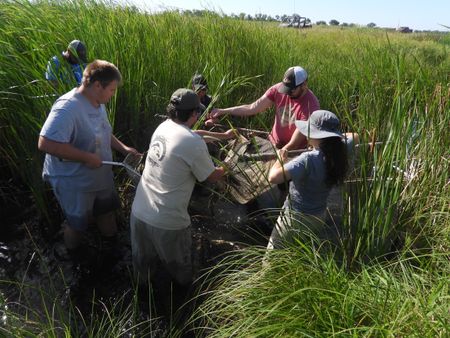
The Crane Trust’s fish survey Fridays are wrapping up for the summer! We’ve had a lot of fun in wetland sloughs, seining for fish and searching for macroinvertebrates. Sloughs at the Crane Trust are groundwater-fed and can maintain a surprising amount of fish of several different species. The health and diversity of fish and invertebrates in the Platte River and surrounding wetlands are critical for migrating cranes and the long-term resilience of other wildlife and vegetation!

Fish and invertebrate surveys are important because many factors can impact their diversity and abundance. Land use, extensive groundwater pumping, and climate change all threaten groundwater availability for fish, and aquatic insects, and therefore threaten entire ecosystems.
At the Crane Trust, we survey two major sloughs each year, heading out on Friday mornings for the adventure! Before the fun of collecting fish, we first focus on some water quality measurements. These include things like water turbidity, temperature, pH, water depth, and dissolved oxygen - all important metrics for long-term data collection. We’ll also note the presence of invasive plant species.

After these measurements are taken, we get to catch some fish! To do this, we'll have a couple of people holding a big seine net for sweeping through the slough, while other folks “scare” fish into the net by splashing towards it. This method works to get as many fish into the net as possible. Then, we’ll work together to sort through the net, tallying the numbers of fish of each species. Native fish we find are the Plains Topminnow, Brassy Minnow, Green Sunfish, Northern Plains Killifish, and Sand Shiners, amongst many others!
 Green Sunfish
Green Sunfish
 Plains Topminnow
Plains Topminnow

The invasive Western Mosquitofish (Gambusia affinis) is also a species of note. They negatively impact native fish populations (many of them threatened or endangered) through competition, habitat displacement, and even feeding on other fish eggs. They may be contributing to the decline in Nebraska’s Plains Topminnow distribution (Plains Topminnows rely heavily on spring-fed pools). We look at changes in the mosquitofish population over time to help inform management decisions.

 Plains Killifish
Plains Killifish
While our surveys predominantly focus on wetland sloughs, we’ll head out to the Platte next week to see what we find! Surveying fish populations in the Platte River is also very important, especially with drought and drying channels.
 Larval stage Odonata
Larval stage Odonata
Back soon!
Charlie, Crane Trust Saunders Conservation Fellow

